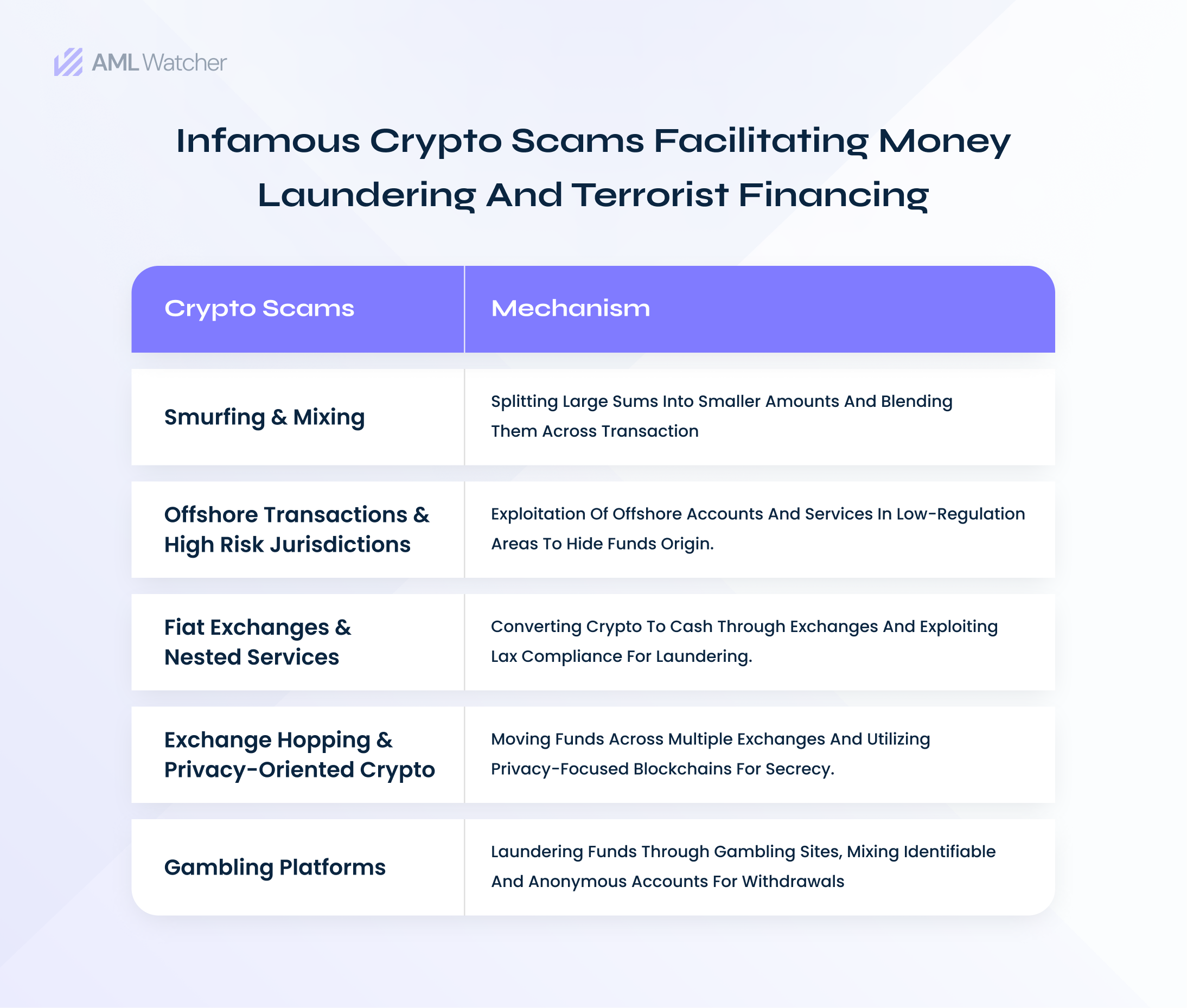
Everything You Need To Know About AML Crypto
You might find varying views on the future of cryptocurrency from it being the only official money to an illegal asset but what can not be denied is the evolution of AML in crypto and virtual assets. Continuing to leave a lesson for institutions dealing in virtual assets particularly crypto, the FinCEN (Financial Crimes Enforcement Network) and CFTC (Commodity Futures Trading Commission) imposed a civil money penalty (CMP) of $100 million on BitMEX, a crypto exchange platform. The alleged crypto experts at BitMEX willfully violated AML (anti-money laundering) and BSA (bank secrecy act) compliance while motivating others to not ignore AML crypto no more.
In a world of virtual typologies where compliance challenges keep on unfolding, this virtual journey of crypto AML will address some of the major questions you may have before entering into the crypto business.
What is AML in Crypto?
Employment of vigilant compliance measures against predicate crimes such as money laundering and terrorist and proliferation financing has always been a prime focus for global anti-money laundering and counter terrorist financing (CTF) gatekeepers. According to the collected stats in 2023, more than 20% of the U.S population owns or trades in virtual assets while some call it the future of trading and currency.
The decentralized nature of financial flow in cryptocurrency unlike fiat currency empowers the execution of money laundering where layering and integration of illegal finances into the licit financial network appears to be untraceable. Complementing the prime importance of AML compliance in traditional finance, AML and CTF measures and legislations in decentralized finance have become the hot concern for global AML regulators. Therefore, crypto AML compliance stands paramount to hinder the bad guys from converting their illegal gains to clean assets through cryptocurrency and custodian services.
Why Does Crypto Need AML Compliance?
Identified through the blockchain data, the UNODC (United Nations Office of Drugs and Crimes) reported that crypto exchanges are the most popular medium for bad guys to launder their illicit proceeds gained from organized crimes in Southeast Asia including Cambodia, Thailand, Myanmar, and Laos.
If I try to pin down the magnitude of the AML risks in cryptocurrency, it is not possible to bypass the fact that in 2023, crypto flow of worth $24.2 billion was traced down to shadowed crypto receivers including cyber fraudsters while $14.9 billion of the transactional volume contributed to illicit flows of sanctioned jurisdictions.
Opening doors to being sanctioned by the OFAC (Office of Foreign Assets Control), two OTC (Over The Counter) crypto brokers named Suex and Chatex facilitated the movement of cryptocurrency in billions received and deposited by the cyber scammers.
Read the tale of FTX collapse where AML in crypto went wrong.
With a common goal of converting dirty money to clean proceeds and hiding criminal trails, both traditional and virtual money laundering activities need to be stemmed by meeting the requirements of crypto AML regulations.
How AML Regulations are Evolving in Crypto?
The Atlantic Council study reveals a significant gap between growing crypto adaptation and imposed regulations. Irrespective of the fact that cryptocurrency is being legally used in 20 countries, only 70% (14 out of 20) of the said jurisdictions have established a regulatory framework of AML/CTF for virtual assets and cryptocurrency. However, crypto has gained legal status in ten out of G20 countries while 50% of the global GDP accounts for virtual assets and cryptocurrency. Let’s take a look at the global efforts of endorsing AML for crypto and how different jurisdictions have put their coins in the global bank of compliance.
FATF Regulations on Crypto & Virtual Assets
With a necessary update in the existing recommendations on AML risks, the Financial Action Task Force (FATF), a global AML regulatory body has endorsed the employment of a risk-based approach when dealing with virtual assets (VAs) and VASPs (Virtual Asset Service Providers). The placed guidelines address the classification of VAs and VASPs while AML risks and tools have also been advised to be regulated in peer-to-peer transactions.
AML Crypto Compliance by the Travel Rule & MiCA
To meet the existing regulatory and compliance gaps, various jurisdictions have put their stable efforts into bringing clarity to AML requirements in crypto and virtual assets. The infamous Travel Rule which is also known as the TFR (Transfer of Funds Regulations) establishes a transactional threshold to collect the beneficiary and information of currency origin while different threshold limits have been adopted by different jurisdictions. Showing no mercy to the AML threats, the EU has imposed the rule on all sizes and kinds of crypto transactions.
In 2023, the MiCA regulation was enforced by the European Parliament to protect crypto consumers from money launderers and cyber fraudsters. The regulation sets guidelines for the crypto service providers to take effective AML measures and licensing requirements for crypto businesses operating in the EU.
NPRM to Enforce AML in Crypto
The abuse of crypto in the form of CVC (Convertible Virtual Currency) mixing has been attempted to stem by the FinCEN through an NPRM (Notice of Proposed Rule Making). The legislative guidelines require virtual financial institutions to implement enhanced transparency and AML crypto checks while addressing the increasing money laundering risks in CVC mixing.
The effective implementation of regulations and AML guidelines requires a clear understanding of how money laundering is facilitated through virtual assets and cryptocurrency. Below is the comprehensive map of scams and methods used by the crypto crime actors to achieve illicit aims.
What Does AML Compliance Require from Crypto Businesses?
The fraudulent activities and scams in crypto can vary in their nature as explained before but what stays constant is the crypto AML compliance expectation. Where aligning with the global AML regulations for crypto is challenging, the implementation of said statutes brings a clean and legalized future for virtual assets. With offering room to foster compliance culture in both traditional and decentralized financial activities, a practical and efficient compliance program, not limited to, includes the following.
Risk Assessment & Continuous Monitoring
The businesses are required to establish functional policies and procedures to implement a risk-based approach and client ongoing monitoring. To stay ahead of compliance failure, crypto AML methodologies must be updated and aligned with the changing risk profiles of clients and business partners. Identification of the suspicious activities associated with clients, reporting of such activities by using SARs (suspicious activity reports), and regular audits of existing AML measures allow the crypto business to combat virtual assets abuse.
Customer Due Diligence
The practice of customer due diligence by means of KYC (know your customer), EDD (enhanced due diligence), and customer screening enables institutions to filter out the AML risk before allowing it to rust the integrity of the financial system. It requires the verification and screening of clients using biometric AML verification, sanctions check, adverse media checks, and increased monitoring protocols for politically exposed persons (PEPs) on a regular and ongoing basis.
Automated Tools and AML Crypto Compliance
The employment of efficient and easy AML screening tools to meet the crypto compliance requirements is imperative more than ever. The market size of cloud based AML solutions is predicted to reach $6.8 billion by the end of 2028 and the stats support the non-negotiable need of crypto AML services and tools to fight the evolving financial crimes. The unforgiving compliance requirements demand the institutions to adopt advanced technology embedded with artificial intelligence (AI) and machine learning (ML) to monitor the transactions and customers.
It is crucial to understand the AML in crypto compliance however, protecting your business of whether virtual or traditional finance requires a trustworthy partnership to design and implement an efficient crypto AML compliance program.
How to Meet AML Compliance with AML Watcher?
The complicated expectations of AML in crypto compliance requires a solution that must be efficient enough to not let any corrupt actor enter into the financial fiber of your business and easier enough to not need any additional burden of operating it. AML Watcher does that for you. Our innovative and research driven AML tool empowers your compliance with faster and easier screening while not missing on any regulatory guideline. Facilitating risk profiling and organized reporting, AML Watcher offers customized AML solutions to meet your compliance needs and challenges.
Explore our live screening tool against sanctions and PEP checks and find out how meeting compliance can be efficient yet easier.
We are here to consult you
Switch to AML Watcher today and reduce your current AML cost by 50% - no questions asked.
- Find right product and pricing for your business
- Get your current solution provider audit & minimise your changeover risk
- Gain expert insights with quick response time to your queries




